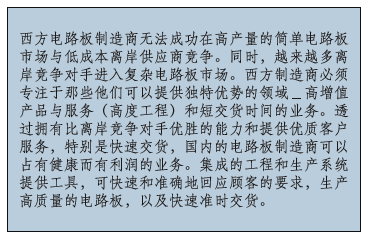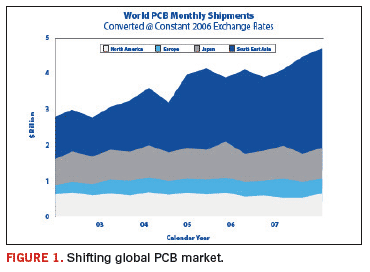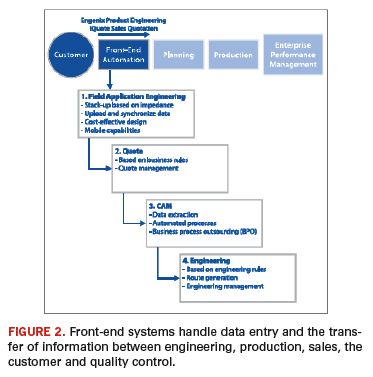
Engineering systems capture detailed customer specifications and transfer design and quote information to fabrication, reducing time and improving quality.
There’s no question that the printed circuit board (PCB) manufacturing market has changed dramatically in recent years. In the past, 30% of the world’s production took place in Europe and North America, but by 2007, that market share had declined to 17% with the majority of production coming from China, Japan and the rest of Asia (Figure 1).

This situation is by no means unique–the migration of manufacturing from industrialized countries to emerging areas of the world is a well-documented pattern that has been observed in everything from consumer electronics to construction equipment. As markets migrate to these emerging countries with low-cost suppliers, what can manufacturers in Europe and North America do to compete?
The answer lies in the particular mix of skills and capabilities that is not easily duplicated by a supplier halfway around the world. In short, the best opportunities are located in: high-value-added products, highly engineered services and quick-turn businesses. Staying ahead of the capabilities of these evolving competitors is critical in terms of engineering and other value-added services. In terms of production, it is the ability to manufacture increasingly complex, HDI, controlled impedance and high-layer count boards, in relatively small quantities, quickly.
Taking the lead with new technologies and processes is also an important advantage. For example, take the evolving trend toward embedded components. Eventually, low-wage overseas competitors will be able to tackle these technologies as well, but the Western producer should be moving ahead to the next innovation before that happens.
Despite the above concerns and strategies, PCB fabricators continue to face many of the same basic challenges that have proven to be critical concerns for years: effective sales strategies, cost control (including the ever-present need to increase yield) and customer service.
Sales efforts must focus on those opportunities in which the supplier’s strengths provide a reasonable chance of success. It makes little sense to expend a large amount of effort chasing business that will likely go to low-cost producers in Asia. Once the prospect base is clearly identified and characterized, the supplier must aggressively pursue opportunities. This means generating numerous quotes–quickly and accurately. Success is all in the numbers; more viable quotes lead to more sales. Of course, having the right specifications and requirements and making sure they are passed down correctly to the production floor is a critically important part of the process. Therefore, integrated engineering and production systems are essential, given the complexity of today’s PCB designs and requirements.
Suppliers in the same geographic region should have a built-in advantage in customer service. Free from language, time-zone and cultural boundaries, local suppliers should be able to better understand requirements and needs, offer products and services tailored to the needs of local markets and respond quickly with quotes and production to meet or to exceed expectations. Offering an expanded range of products and services, including engineering, local suppliers should endeavor to become partners with key customers, assisting in the design and the application of the latest technologies and techniques to produce boards that elevate the functionality and utility of the products.
High value-adding suppliers can ensure quality, quick on-time delivery and fewer errors through engineering services and direct transfer of Gerber files, adding a high level of automation and quality control in the plant. Fortunately, information technology continues to evolve by delivering more capabilities that address the growing needs of manufacturers. The most important characteristics of information systems today are breadth and integration.
The suite of software needed to support the quest for quality, responsiveness, cost control and customer service must address the full range of business activities–engineering, sales, quoting, production, shipping, quality and accounting/finance–and be fully integrated to provide speed, accuracy and coordination throughout the enterprise and across the supply chain. Many PCB manufacturers are multi-site and engage in close partnerships with other suppliers around the world. Comprehensive and well-integrated information systems allow these companies to appear and to respond as a single resource for the customer, thus providing a full range of products and services that, to the customer, appear to come from one entity.
Engineering can be the most time-consuming part of the job, especially when targeting some of the more complex board types. And oftentimes, these jobs are prototypes or first-runs with severe time constraints. Non-integrated systems can add to the problem by requiring redundant data entry and by not supporting collaboration or seamless transfer of information between engineering, production, sales, the customer and quality control.
With an integrated system, specifications can be transferred electronically from the customer into the engineering system. After validation and detailed engineering, the information moves electronically to the quoting system (or the two are, in fact, parts of the same system) to ensure accuracy and completeness of the quote and pricing. After customer sign-off, the data can move directly into the production and quality systems with no risk of keying errors. Late changes, quality measurements and actual costs are captured and stored along with the complete history of the design and the order information. (Figure 2).

Customers for high-tech, complex boards seem to always be in a hurry. They want immediate response when requesting a quote, and they expect the final product engineering information to be complete and accurate. They must be able to apply costing/pricing logic to generate customer quotes and to build engineering and business information that will be used to initiate manufacturing once the contract is awarded. Automated workflows manage the process and supervise distribution and coordination between all participating parties – engineering, sales, production, materials/procurement, quality, management and the prospective customer.
Enterprise Resource Planning (ERP) applys company resources most effectively and efficiently to meet customer expectations, minimize costs and maximize profits. But one-size-fits-all ERP will not deliver these benefits in a PCB plant. Specialized ERP, developed specifically for the PCB industry, recognizes the high engineering content, continuous nature of processes, stringent quality requirements and the need for agility.
Circuit board manufacturers in the West cannot compete successfully with lower-cost offshore suppliers in the higher-volume and simpler-board markets. And, increasingly, offshore competitors are entering the complex board market. Western manufacturers must focus on those areas where they offer unique advantages – in high value-added products and services (highly engineered) and short turn-around business.
By staying ahead of offshore competitors’ capabilities and by delivering superior customer service, especially quick turn, domestic board producers can carve out a healthy, profitable business. Integrated engineering and production systems provide the tools to quickly and to accurately respond to customer requests, to produce high-quality boards and to deliver on time. PCD&F
Mehul Dave is VP of international operations at Consona Corporation and can be reached at This email address is being protected from spambots. You need JavaScript enabled to view it..
















